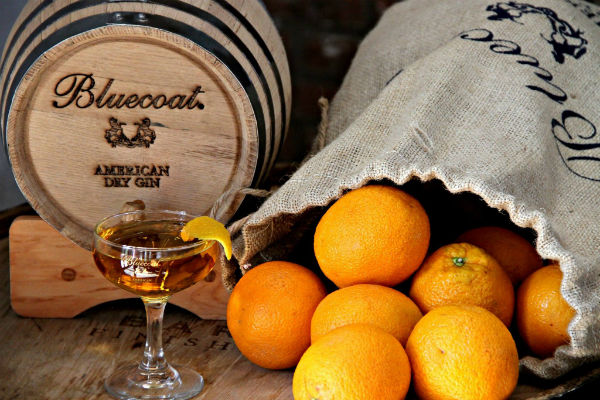Slide over, Scotch. Back to the bar with you, bourbon. Run on home, rum. There’s a new brown-ish spirit in town: barrel-finished gin.
Barrel-finished gin – also categorized as barrel-aged or barrel-rested gin – is one of the craft spirit industry’s fastest growing spirit innovations. Similar to the way whiskey and rum age in oak barrels, craft distillers are giving their gins some time in barrels as well.
We reached out to Bluecoat Gin co-founder, Andrew Auwerda, to learn more about this new innovative spirit category.
Why did you decide to start barrel-finishing Bluecoat gin?
Andrew Auwerda: It is no secret that the brown spirit category is hotter than ever. As a gin company, we wanted to find a way to be a part of that brown spirit movement, but do so in an authentic way that wouldn’t jeopardize Bluecoat as a brand. For us, that meant creating what I describe as a “ginskey.” There are a lot of barrel-finished gins out there that drink more like a bourbon than gin. Bluecoat’s barrel-finished gin is first and foremost Bluecoat gin and we make sure all of our trademark flavors are front and center. It still tastes like gin, but it has a whiskey kick.
When did the barrel-finished gin trend start?
AA: It may appear that the trend is only five or six years old, but ask yourself this: How was gin moved around during the time our country was founded? It was most likely transported in wooden barrels. Obviously, it wasn’t aged in barrels for as long as distillers are barreling gins today, but the gins of that era must certainly have picked up some color and flavor from their time spend in the barrel.
How does the barrel transform the gin?
AA: The barrel gives the gin all those buttery and caramel flavors we commonly think of as bourbon notes. The barrel also softens the gin and gives the spirit a more rounded mouthfeel.

What makes Bluecoat’s barrel-finished Gin different than others in the market?
AA: One of the things that we pride ourselves on is that our barrel-finished gin is just two things: Bluecoat gin and wood. We use brand new American oak barrels. When we first get the barrels in, we add the gin and let them rest together for three-to-five months. We then remove that spirit, put it in a tank for holding, add new gin to that now seasoned barrel and let that rest for six-to-nine months. We then blend those two spirits together. The resulting bottle is two-thirds first use barrels and one-third second use barrels, which for us was the perfect combination of big gin notes and soft, sweet barrel character.
What are a few of your favorite ways to serve the barrel-finished gin?
AA: We had this huge education curve, as you can imagine, with brown gin. Gin is tough for a lot of people. There are a lot of preconceptions and stories of people not having the best experience with gin. We knew we had a huge challenge in that sense, but liquid-to-liquid, barrel-finished gin can challenge a lot of whiskeys out there. It is more interesting and has more depth and complexity than whiskey. With that in mind, we encourage customers to use the barrel-finished gin in place of a whiskey in classic cocktails like the Manhattan and Old Fashioned. Classic gin drinks like the Negroni and the Martinez are also particularly interesting with the barrel-finish.